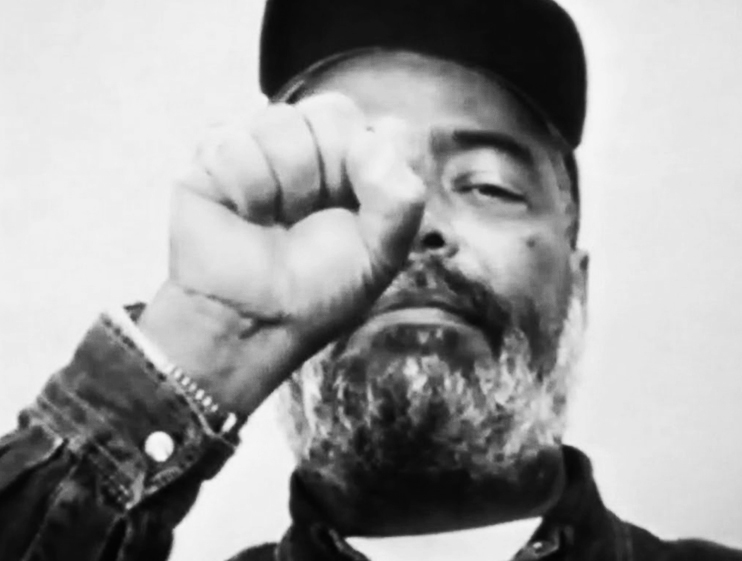20.08.2017 – 10.09.2017
Cours, cours, camarade, le vieux monde est derrière toi – The Cinema of Med Hondo
Exhibition by Theo Eshetu
Double Feature Picture Show
8-channel video installation
A collaborative project at Arsenal – Institute for Film and Video Art, Archive Kabinett, silent green Kulturquartier and SAVVY Contemporary
Opening, 20 August 2017, 7pm
Workshop 3 September, 3-6pm
Curated by Enoka Ayemba, Marie-Hélène Gutberlet, Brigitta Kuster
“Run comrade, the old world is behind you,” is one of the slogans hoisted by the French 1968 movement, which eventually found its way into SOLEIL Ô (1969), Med Hondo’s best known film. Filmmaker, actor, and voice-actor, Med Hondo was born in Mauritania and subsequently emigrated to France, where has been living in the Parisian suburbs for more than fifty years.
His work forms the epicentre of a wide-ranging, research-based and discussion-intensive film and exhibition programme. Curated by Enoka Ayemba, Marie-Hélène Gutberlet, and Brigitta Kuster, the programme aims to raise awareness about Med Hondo’s extraordinary body of work, to stimulate its appreciation, and thus contribute to making it accessible for future generations as well.
Med Hondo’s short film MES VOISINS (Our Neighbours, 1971) is the starting point for a multi-faceted exhibition with moving pictures and sound productions from Theo Eshetu, Sebastian Bodirsky and Guy Woueté. In strikingly contrasting forms and approaches, these artists question perspectives of self-determined media representation of the African continent and the African diaspora; they examine the impact and physicality of images, the history, and cultural codes attached to them.
Every single one of Med Hondo’s films specifically frames the question, what does cinema mean from an African perspective. In “What is Cinema for Us?” published in Framework in 1979, Med Hondo reworks this incisive question, which reverberates in the exhibition’s video installations. Addressing structures and practices in which representations, cultural codes, art, history, and culture can be produced and questioned, the installations pick up on the reflective nature of cinema, rendering it inventive in a space outside cinema logic, thus interpreting affinities and frictions between languages, sound and image, between film and art.
Med Hondo has persistently denounced African cinema’s lack of independence, calling for an own African cinema as well as an autonomous discourse on it. In Theo Eshetu’s video installation Double Feature Picture Show—the upshot of his interaction with Med Hondo’s work—moving images from diverse sources and angles converge so as to render the exhibition space an uncovered cinematic arrangement. Replicating cinema, Theo Eshetu creates a constellation of mutually facing and observing monitors.
In 2010 Theo Eshetu was invited by Bozar, Brussels’ Centre for Fine Arts, to participate as an artist in the exhibition project Visionary Africa in Ouagadougou, home of the FESPACO lm festival. Double Feature Picture Show elaborates on and deepens his approach to African cinema and the African audience and relates it to the understanding of working as a video artist and filmmaker. The work establishes a self-reflective meta-level that takes into consideration the yearning associated with cinema.
The film and exhibition programme on Med Hondo’s work is expanded in the venues Kino Arsenal, Archive Kabinett and SAVVY Contemporary with a series of specifically inserted commentaries, referred to as “footnotes”. Like footnotes to a text, the video annotations taken from found footage and the text material highlight specific points and themes in the programme, referring to an aspect that either goes beyond the scope of the main part of the programme or leads in a different direction. Footnotes follow a strict logic, containing sources and evidence. They also provide space within a greater whole—in this case the cinema, exhibition space or library—for detours and special features, using an appealing small form to accomplish this dual focus. As curatorial commentaries, they also provide a common thread that links the exhibition venues and the different programme points with one another.
For the other parts of the project, please visit
The project is being supported by the TURN fund of the Federal Cultural Foundation. With thanks to the Zentrum Moderner Orient, Berlin, Goethe-Institut Yaoundé, Arsenal – Institute for Film and Video Art, SAVVY Contemporary and silent green Kulturquartier.
The full program can be downloaded here.

